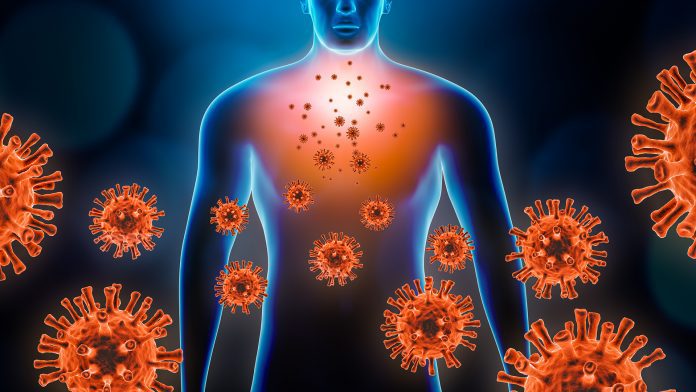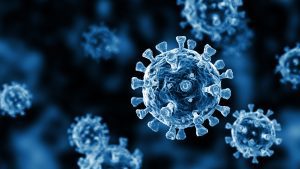
Jesmond Dalli, Professor of Molecular Pharmacology, Sir Henry Dale Fellow and Lipid Mediator Unit Director, discusses new insights into the processes that contribute to chronic inflammation in COVID-19 patients.
COVID-19 can affect people with varying severity. While for some, the virus produces minimal side effects, for others, it can be detrimental, resulting in hospitalisations or even loss of life. Those that suffer with chronic diseases, such as heart disease or cancer, are much more likely to need intensive care. It appears that these patients have a greater inflammatory response when infected with COVID-19. However, until recently there has been limited understanding around the processes that lead to chronic inflammation in patients who contract the virus.
Researchers from a Queen Mary University of London led a study which explored how the production of protective molecules, known as specialised pro-resolving mediators (SPM), is altered in patients infected with COVID-19. The study found a link between decreased SPM blood levels and disrupted white blood cell responses in patients with a higher disease burden. Treatments that increase SPM production, such as dexamethasone, could help limit inflammation.
Likewise, with new treatments being developed, it may be easier to predict patient outcomes and to pre-emptively start treatment before conditions worsen. Health Europa spoke to Jesmond Dalli, Professor of Molecular Pharmacology and Lipid Mediator Unit Director at Queen Mary University of London, about his recent study and how SPM-based therapeutics could be beneficial in treating infections without compromising the body’s automatic immune response.
What causes chronic inflammation in patients with COVID-19? Are certain people more susceptible to this?
That is still an open question. We only learned about COVID-19 a year and a half ago and there are still questions about diseases that we have known about for decades. It is clear that there are multiple factors as well as situations where the body is already fighting an inflammatory disease. Patients who have secondary diseases that are chronic, particularly those with conditions affecting the lungs, heart, and kidneys, tend to be more susceptible to COVID-19.
From our perspective as scientists, what we see is a situation where the immune response seems to be unable to initially deal with the virus. Then, subsequently what is seen is a situation where the immune response gets so out of control that inflammation spreads from the lung – which is the primary site of infection – to the other organs. There is evidence, particularly early on, that the virus can be located in other organs apart from the lungs. However, I do not think there has ever been conclusive evidence that this dissemination of the virus to other organs is what leads to this additional inflammation. It is simply a consequence of cells carrying the virus from the lungs to other organs. The inflammatory response would have already occurred despite the presence of the virus.
In fact, in many patients, particularly those that get severe COVID and end up in hospital with serious conditions, there is not a widespread dissemination of viruses. It is this dissemination of inflammation from the lungs to other organs that drives the disease that we know as COVID-19.
The SARS-CoV-2 infection is like any other infection, it can affect the lungs but usually you do not get disseminated inflammation and it is not so severe that you need to be hospitalised. The interesting thing about the SARS-CoV-2 virus is that a low percentage of people end up severely ill but because it is so infective it can still overwhelm the system. When you look at the numbers of infections versus hospitalisations, even prior to vaccination, it was always relatively small but because of the high degree of infectivity, that number was still remarkable and sufficient to collapse even the most efficient health systems around the world.
How easy is it to detect this chronic inflammation?
At the moment, there is no way of telling whether a patient is going to get severe symptoms or is just going to ride it out. Recently, we published a paper and are working on another, that looks at this early signature for patients who go on to develop severe symptoms and end up in ICU. The initial results obtained in a relatively small number of patients suggest that the production of SPM, the protective molecules our body produces to curb inflammation, may be impaired in those patients who go on to develop severe disease.

Clinicians have got better at spotting those patients who could develop severe symptoms, particularly those who are on the frontline, but that is already when the patient is in hospital and therefore at an advanced stage of this inflammatory response. So, there is no way to tell early on what the clinical outcome for each patient is going to be. Our findings suggest that SPM levels might be useful indicators of how a patient with COVID-19 is likely to fare. This is an interesting observation since it determining whether a patient is likely to develop severe disease or not will help the doctors identify better and more effective treatments for these patients.
What did your study reveal about the body’s response to COVID-19 in patients with a higher disease burden?
Our study revealed that in patients with COVID-19 the body is unable to produce SPM. We also found that there was a decrease in the abundance of proteins that produce these molecules in white blood cells. This observation may explain why hospitalised patients with COVID-19 display chronic inflammation. Indeed, SPM are our health insurance; they are produced by the body to control inflammation and so their loss leads to a situation that is equivalent to a car in motion without breaks.
Reassuringly we found that dexamethasone, a medicine that is used to treat patients with COVID-19, increases their ability to produce SPM an observation that explains why this drug can limit chronic inflammation in these patients.

Therefore, our findings suggest that SPM levels might be useful early indicators of how a patient with COVID-19 is likely to fare. This is an interesting observation since determining early on whether a patient is likely to develop severe disease or not will help doctors identify better and more effective treatments for these patients. Furthermore, they also suggest that either using medicines that rectify the body’s ability to produce SPM or SPM as medicines may prove to be useful new ways in treating patients with COVID-19.
Why should we be looking to use these molecules to treat patients with COVID-19 or other inflammatory conditions?
Dexamethasone is one of the cheapest drugs available and it has been used to treat inflammatory diseases for many years. It is effective, but it carries a whole host of side effects. Because of its level of toxicity, it can only be given in higher doses for a small period of time. The patient can be exposed to infections because dexamethasone suppresses the immune response. In our pharmacopoeia, all the drugs that we use, including the ones that are being developed of repurposed for COVID-19 treatments, are all designed to inhibit something.
The problem with that, however, is that anything that the body produces has a purpose. It might be that in one organ it happens to increase inflammation but, in another organ, it is protective. A classic example are prostaglandins which are the target of non-steroidal anti-inflammatories (NSAIDs) including aspirin, paracetamol, and ibuprofen. In many organs prostaglandins are inflammatory and they are linked with inflammation. In the gut, on the other hand, they are central to barrier function. The problem with giving NSAIDs for a long period of time is that you get gastrointestinal (GI) bleeds, one of the biggest side effects of NSAID treatment.
SPM on the other hand instruct the cells to reduce the production of molecules that propagate inflammation and to increase those that repair damaged tissues. Furthermore, during infections they also instruct cells to identify and clear invading microbes including bacteria and viruses. This provides a distinct advantage to inhibitory drugs since they do not interfere with the body’s ability to respond to a second challenge, like for example injury or another microbe.
Where do you want to take your research next, and how might this influence future treatment options for inflammatory conditions?
We are looking at various aspects. In terms of COVID-19, we are looking at two avenues. One is therapeutic whereby we are exploring the utility of SPM in treating chronic inflammation in patients with COVID-19. The other is to use SPM as diagnostics or biomarkers to be able to tell whether someone is going to do better or worse as early as possible.
The rationale here is that we want to identify those patients that are likely to have a mild disease early on to minimize the interventions and to allow them to recover on their own. Similarly we would also want to identify those patients who are more likely to develop sever disease early on since this would allow doctors to treat them more effectively. This concept is something that we have evidence for in other conditions like arthritis where we can subdivide patients in relation to their disease severity and disease phenotype, and we recently observed that blood SPM levels are linked with the likelihood that patients with arthritis will respond to specific medicines.
The main advantage of this is that you do not expose a patient to a drug that they are unlikely to respond to. Those are the two avenues we are considering going forward, the therapeutic side and the biomarker side.
Jesmond Dalli
Professor in Molecular Pharmacology, Sir Henry Dale Fellow, Lipid Mediator Unit Director
Queen Mary University of London
www.qmul.ac.uk
This article is from issue 19 of Health Europa Quarterly. Click here to get your free subscription today.






















